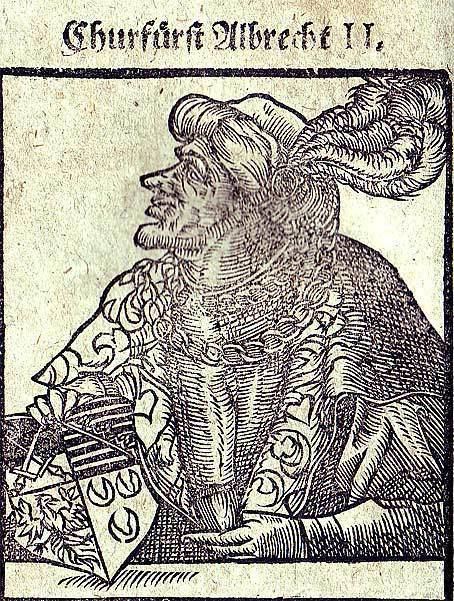Joint Reign 1260–1296 Parents Albert I, Duke of Saxony Spouse Agnes of Habsburg | Name Albert Duke Reign 1296–1298 | |
 | ||
Predecessors Albert II and his nephews Albert III, Eric I and John II (joint rule) Died August 25, 1298, Aken (Elbe), Germany Children Rudolf I, Duke of Saxe-Wittenberg Grandchildren Rudolf II, Duke of Saxe-Wittenberg, Wenceslaus I, Duke of Saxe-Wittenberg | ||
Grandparents Bernhard, Count of Anhalt | ||
Albert II of Saxony (Wittenberg upon Elbe, ca. 1250 – 25 August 1298, near Aken) was a son of Duke Albert I of Saxony and his third wife Helen of Brunswick and Lunenburg, a daughter of Otto the Child. He supported Rudolph I of Germany at his election as Roman king and became his son-in-law. After the death of their father Albert I in 1260 Albert II jointly ruled the Duchy of Saxony with his elder brother John I, and thereafter with the latter's sons.
Contents

Life
In 1269, 1272 and 1282 the brothers gradually divided their governing competences within the three territorially unconnected Saxon areas (one called Land of Hadeln around Otterndorf, another around Lauenburg upon Elbe and the third around Wittenberg), thus preparing a partition.
In the imperial election in 1273 Albert II represented the jointly ruling brothers. In return Rudolph I had married his daughter Agnes of Habsburg to Albert II. After John I had resigned in 1282 in favour of his three minor sons Eric I, John II and Albert III, followed by his death three years later, the three brothers and their uncle Albert II continued the joint rule in Saxony.
In 1288 Albert II applied to King Rudolph I for the enfeoffment of his son and heir Duke Rudolf I with the Electorate of Saxony, which ensued a long lasting dispute with the eager clan of the House of Wettin. When the County of Brehna was reverted to the Empire after the extinction of its comital family the king enfeoffed Duke Rudolf. In 1290 Albert II gained the County of Brehna and in 1295 the County of Gommern for Saxony. King Wenceslaus II of Bohemia succeeded in bringing Albert II in favour of electing Adolf of Germany as new emperor: Albert II signed an elector pact on 29 November 1291 that he would vote the same as Wenceslaus. On 27 April 1292 Albert II, with his nephews still minor, wielded the Saxon electoral vote, electing Adolf of Germany.
The last document, mentioning the joint government of Albert II with his nephews as Saxon fellow dukes dates back to 1295. The definite partitioning of the Duchy of Saxony into Saxe-Lauenburg, jointly ruled by the brothers Albert III, Eric I and John II and Saxe-Wittenberg, ruled by Albert II took place before 20 September 1296, when the Vierlande, Sadelbande (Land of Lauenburg), the Land of Ratzeburg, the Land of Darzing (later Amt Neuhaus), and the Land of Hadeln are mentioned as the separate territory of the brothers. Albert II received Saxe-Wittenberg around the eponymous city and Belzig. Albert II thus became the founder of the Ascanian line of Saxe-Wittenberg.
Marriage and issue
In 1282 Albert II married Agnes of Habsburg, daughter of Rudolf I of Germany, making her one of the Saxon Consorts, and they had the following children:
